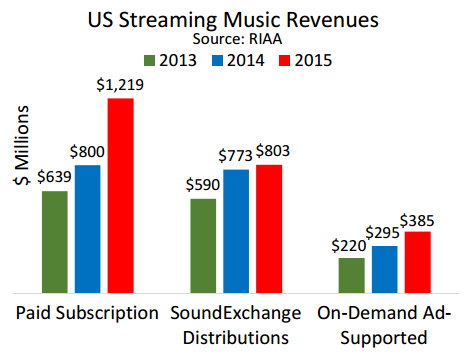Subscription Streaming Now Top Revenue Source for Music Industry

“The music industry is now a digital business, deriving more than 70 percent of its revenues from a wide array of digital platforms and formats,” said Cary Sherman, RIAA chairman and CEO… “In 2015, digital music subscription services reached new all-time highs, generating more than $1 billion in revenues for the first time, and averaging nearly 11 million paid subscriptions for the year. Heading into 2016, the number of subscriptions swelled even higher—more than 13 million by the end of December— holding great promise for this year.”
But all is not rosy, according to RIAA. “The consumption of music is skyrocketing, but revenues for creators have not kept pace,” Sherman said. “In 2015, fans listened to hundreds of billions of audio and video music streams through on-demand ad-supported digital services like YouTube, but revenues from such services have been meager—far less than other kinds of music services.”
Citing an “alarming disparity” between the growth in the number of ad-supported streams compared with growth in revenues generated from those streams, he said “the problem is getting worse” and noted that sales of 17 million vinyl albums generated revenues of $416 million compared with $385 million generated by “billions and billions of on-demand free streams.”
From the RIAA report:
2015 was a milestone year for streaming music. For the first time, streaming was the largest component of industry revenues, comprising 34.3% of the market, just slightly higher than digital downloads.The streaming category includes revenues from subscription services (such as paid versions of Spotify, TIDAL, and Apple Music, among others), streaming radio service revenues that are distributed by SoundExchange (like Pandora, SiriusXM, and other Internet radio), and other non-subscription on-demand streaming services (such as YouTube, Vevo, and ad-supported Spotify).
All parts of the streaming music market grew in 2015, and total streaming revenues exceeded $2 billion for the first time ever. Combining all categories of streaming music (subscription, ad-supported on-demand, and SoundExchange distributions), revenues grew 29% to $2.4 billion.
Paid subscription services were the biggest — and fastest growing — portion of the streaming market. The launch of new services like TIDAL and Apple Music made this one of the most watched and talked about spaces in the industry. In 2015, revenues from paid subscriptions grew 52% to $1.2 billion. At the same time, the number of paid subscriptions grew 40% to an average of 10.8 million for the full year.
SoundExchange distributions grew 4% to $803 million, and on-demand ad-supported streaming grew 31% y-o-y to $385 million.
Digital accounted for 70% of the overall market by value, compared with 67% in 2014 (note Synchronization excluded from this figure). Even though digital download revenues (including digital tracks and albums) declined 10% to $2.3 billion, the total value of digitally distributed formats was up 6% to $4.8 billion, compared to $4.5 billion in 2014.
Total value of shipments in physical formats was $2.0 billion, down 10% versus the prior year. Vinyl LPs were up 32% by value, and at $416 million were at their highest level since 1988. Synchronization royalties were $203 million, up 7% versus the prior year.
Overall, the data for 2015 shows a music industry that continues to adopt digital distribution platforms for the majority of its revenues. While overall revenue levels were only up slightly, large shifts continued to occur under the surface as streaming continued to increase its market share. In 2015, the industry had the most balanced revenue mix in recent history, with just about 1/3 of revenues coming from each of the major platform categories: streaming, permanent downloads, and physical sales.
























































